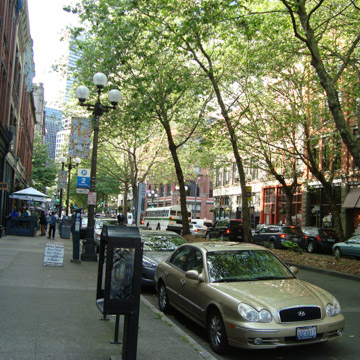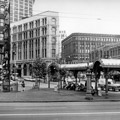Pioneer Square-Skid Road National Historic District
The Pioneer Square Historic District has the distinction of being the first designated historic district in Seattle. It contains the city’s largest collection of late-nineteenth-century buildings, and is one of the largest such collections in Washington state.
During the 1880s, Seattle became the leading city on Puget Sound and in Washington Territory (statehood arrive in late 1889). On June 6, 1889, the mostly wood-frame commercial core of the city burned to the ground. Over the next several years it was rebuilt with larger structures of load-bearing masonry walls and heavy-timber interiors (usually referred to as ordinary masonry construction in Seattle building permits). The rapid reconstruction and nearly uniform use of ordinary masonry construction resulted in a district of remarkable architectural coherence, particularly in the immediate vicinity of Pioneer Square, a small triangular plaza near the corner of First Avenue and Yesler Way originally referred to as Pioneer Place. Most of the buildings from this period tended to variations of the then popular Richardsonian Romanesque style, like the exceptionally fine Seattle National Bank Building (1890–1891, John Parkinson; now known as the Interurban Building); the exuberant Victorian Romanesque Pioneer Building (1889–1891, Elmer H. Fisher; later altered); the stone masonry Bailey Building (1890–1892, Saunders and Houghton); the Dexter Horton Bank (1892, Albert Wickersham; now the Maynard Building); the Union Trust Block (1893, Skilling and Corner); or the Collins Block (1893–1894, A. B. Chamberlin).
The Panic of 1893 ended this initial period of reconstruction, and it was not until after the Klondike Gold Rush of 1897 that significant construction resumed. By this time, commercial growth in Seattle had started its northward trek away from Pioneer Square, with new buildings—typically warehouses and industrial structures—generally located in the southern and eastern portions of what is now the Pioneer Square Historic District. These buildings continued to use ordinary masonry construction, but stylistically tended toward Classical Revival or Chicago School idioms. As such, the district continued to have a pleasing architectural coherence in regards to size, massing, and use of materials. Many of the buildings along the east edge of the district were developed by members of the local Chinese-American community; however, the completion of Union Station (1908–1911, Daniel J. Patterson) increased pressure on both the Chinese-American and Japanese-American communities to relocate to today’s International District. The Smith Tower (1909–1914, Gaggin and Gaggin) was the last Seattle investment by L. C. Smith of Syracuse, who died in 1910; the building itself was a final gesture to anchor the commercial heart of Seattle in Pioneer Square, which ultimately proved to be futile, although its stature at the time as the tallest building west of the Mississippi River helped assure reasonably full rental occupancy.
By the mid-1920s, the district was essentially built-out, with the most significant change coming in the form of the Second Avenue Extension, which connected downtown Seattle with the two railroad stations—effectively eliminating most vestiges of the nineteenth-century Chinatown. Other automobile-related changes included the creation of several garages and repairs shops in the district. The Second Avenue Extension also forced the replacement of the earlier Seattle Fire Department headquarters (1902–1903, Saunders and Lawton). Although this building was not necessarily considered part of the visual blight that included old Chinatown, changes in firefighting equipment and communications easily justified replacement. The new Seattle Fire Department headquarters (1927–1929, Frank L. Baker) was built one block west at Second Avenue South and Main Street, and remained in the Pioneer Square District until the early part of the twenty-first century. An era of benign neglect began in the 1930s with the onset of the Great Depression, and continued until the mid-1960s.
After World War II, a 1949 earthquake resulted in the loss of building cornices and, in some case, entire upper stories, diminishing the aesthetics of many buildings. Still, an appreciation for the architecture found in the Pioneer Square district began to develop. This was first evident with Victor Steinbrueck’s A Guide to Seattle Architecture, published in conjunction with Seattle’s hosting of the national convention of the American Institute of Architects in 1953. Later, when Seattle hosted the Century 21 World’s Fair in 1962, Steinbrueck’s Seattle Cityscape was published with a broader, if non-academic, treatment of the Pioneer Square District as a significant enclave of Seattle’s built environment. In 1963, architect Ralph Anderson purchased the former Capital Brewing Company Building (1901–1902, C. A. Breitung) and rehabilitated the street-level space as an art gallery and occupied the upper stories with his architectural office. This has generally been cited as the turning point in proving the value of rehabilitating existing structures in the district rather than demolishing them for parking garages or paved lots.
Nonetheless, when the City of Seattle was looking at areas of the city in need of urban renewal, the Pioneer Square District was a prime candidate. The urban renewal plan developed by John Graham and Company did include retention of isolated blocks of historic structures, but it tended to focus more on the elimination of buildings in favor of parking for new office developments, as occurred with the demolition of the former Occidental Hotel (1890–1891, Stephen Meany; later known as the Seattle Hotel), which was replaced with the Second and James Parking Garage (1961–1963, Mandeville and Berge). The loss of one of Meany’s finest designs—a Classical Revival flatiron building—galvanized many in the community to assure preservation of the district.
Throughout the 1960s, more Pioneer Square buildings were rehabilitated, often to house art galleries and new restaurants, as well as professional offices, like the Union Trust Block (1965, Ralph Anderson) and the One Yesler Way Building (1967, Alfred Croonquist and Associates), convincing the city to shelve the John Graham and Company urban renewal plan. During this time, the Municipal Art Commission surveyed the buildings in the district for inclusion in a nomination report by Margaret A. Corley of the Seattle Historical Society (now the Museum of History and Industry or MOHAI) that, in 1969, nominated the district for listing on the National Register of Historic Places, which occurred in 1970.
The late 1970s and early 1980s were the heyday for district preservation projects. This was heralded by the long-awaited rehabilitation of the Pioneer Building by Ralph Anderson and Partners (1973–1976), and followed by the Maynard Building (1975, Olson/Walker Architects); the Bailey Building (1975, Jones and Jones); the Marshal-Walker Block (1982, Jones and Jones); the Heritage Building (1982–1983, NBBJ Group); the Mutual Life Building (1984, Olson/Walker Architects); and Merrill Place (1984–1985, NBBJ Group with Olson/Walker Architects). A rare new construction project was the replacement of the collapsed Olympic Block with a new concrete and glass structure designed in 1982–1986 by HOWDI (a joint-venture firm of Hewitt/Daly/Isley and Olson/Walker Architects); this project also included the rehabilitation of the adjacent Lippy Building and City Club on First Avenue South.
Although projects like Merrill Place and 80 South Jackson (1982, Hewitt/Daly/Isley), which rehabilitated the L.C. Smith Building (1900, Max Umbrecht) and the Squires Block (1900, C. H. Bebb) for use as residential condominiums, included significant housing components, there has been a growing emphasis on increasing the number of residents in the district. The Florentine condominium (1990–1991, Alexander and Ventura), a former warehouse converted into 108 residential units, was a notable success. More recent residential projects include T.F. Borset Architects and BOLA’s 2003–2005 conversion of the Lowman Building (1902–1903, de Neuf and Heide) into a 132-unit residence overlooking Fortson Square. Stadium Place North (2010–present, Zimmer Gunsul Frasca Architects with Ankrom Moisan Architects) is scheduled to add some 740 units in a multi-building complex on the north parking lot of CenturyLink Field (1997–2002, Ellerbe Becket with LMN architects), home of the Seattle Seahawks football team and Seattle Sounder soccer team.
The recent increase in residential units coincided with a significant building boom in Seattle, which has resulted in more new construction within the historic district than any time since the district was established. The size and design quality of individual projects has varied, raising questions about appropriate scale. Butler Block (1889–1890, Parkinson and Evers; altered), for example, which had been converted to a garage in 1933–1934 by Henry Bittman, was expanded in 1999–2001 by Hewitt Architects to include twelve stories of parking. With the Quintessa Apartments, a thirteen-story narrow tower faces Fortson Square but still manages to be shorter than the Frye Hotel building (1906–1908, Bebb and Mendel) to the immediate east. 200 Occidental (2013–2016, Mithun Architects) places a seven-story office building housing the Weyerhaeuser Corporation on the east side of Occidental Park, replacing one of the largest surface parking lots in the district. 80 South Main (2013–2016, Clark Design Group) places a seven-story residential structure on South Main Street near Alaskan Way. More recently, a proposed eleven-story structure with 200 market-rate housing units at 316 Alaskan Way faced legal challenges over its scale, and its developer, Urban Visions, proposed a smaller, seven-story office building instead.
Although there are still a number of surface parking lots that break the district’s streetscape, and some buildings remain in need of rehabilitation, the creation of the Pioneer Square Historic District has instilled a popular appreciation of Seattle’s earliest remaining commercial architecture. This was readily emphasized by the interest in replacing the Pioneer Place pergola after its accidental destruction in 2001.
References
Andrews, Mildred Tanner, ed. Pioneer Square: Seattle’s Oldest Neighborhood. Seattle: Pioneer Square Community Association and University of Washington Press, 2005.
Corley, Margaret A., “Pioneer Square-Skid Road Historic District,” King County, Washington. National Register of Historic Places Inventory–Nomination Form, 1970. National Park Service, U.S. Department of the Interior, Washington, D.C.
Krafft, Kathryn Hills, “Pioneer Square-Skid Road Historic District (Boundary Increase),” King County, Washington. National Register of Historic Places Inventory–Nomination Form, 1988. National Park Service, U.S. Department of the Interior, Washington, D.C.
Link, Karin Murr, “Pioneer Square-Skid Road National Historic District,” King County, Washington. National Register of Historic Places Inventory–Nomination Form, 2007. National Park Service, U.S. Department of the Interior, Washington, D.C.
Ochsner, Jeffrey Karl, and Dennis Alan Andersen. Distant Corner: Seattle Architects and the Legacy of H. H. Richardson. Seattle: University of Washington Press, 2003.
Potter, Elizabeth Walton, “Pioneer Square Historic District Expansion Amendment,” National Register of Historic Places Inventory–Nomination Form, 1977. National Park Service, U.S. Department of the Interior, Washington, D.C.
Writing Credits
If SAH Archipedia has been useful to you, please consider supporting it.
SAH Archipedia tells the story of the United States through its buildings, landscapes, and cities. This freely available resource empowers the public with authoritative knowledge that deepens their understanding and appreciation of the built environment. But the Society of Architectural Historians, which created SAH Archipedia with University of Virginia Press, needs your support to maintain the high-caliber research, writing, photography, cartography, editing, design, and programming that make SAH Archipedia a trusted online resource available to all who value the history of place, heritage tourism, and learning.



















